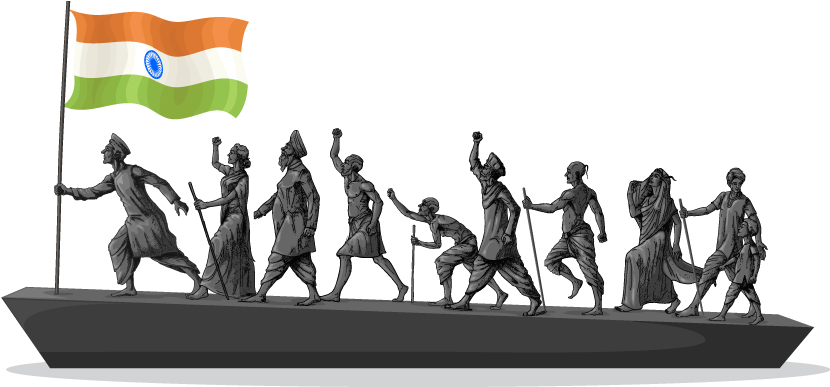
The Primordial God of many forms - #Thread
सिद्धिबुद्धिप्रदं नृणां धर्मार्थकाममोक्षदं |
ब्रह्मरुद्र रवीन्द्राद्यैः संस्तुतं परमर्षिभिः॥
Worshipping the ‘ONE’ Parabrahma propounded in Vēdās principally in six forms is postulated in our Vedic Sanātana Dharma.
सिद्धिबुद्धिप्रदं नृणां धर्मार्थकाममोक्षदं |
ब्रह्मरुद्र रवीन्द्राद्यैः संस्तुतं परमर्षिभिः॥
Worshipping the ‘ONE’ Parabrahma propounded in Vēdās principally in six forms is postulated in our Vedic Sanātana Dharma.

They are Gaṇapati, Viṣṇu, Śiva, Sūrya, Śakti & Subrahmaṇya. As per the decree, ‘Ēkaṁ sat viprā bahudhā vadanti’ i.e., the ONE ‘Sat’ (Truth) present transformed into these different forms. While worshipping Gaṇapati, one should worship as that ‘One Sat’..
which is the Parabrahman that is the cause of creation, sustenance & dissolution. Such worship is called ‘Gāṇāpatya, which is one of the six forms of worship approved by Vēdās. Upaniṣads also confirmed that Gaṇēśa is the Parabrahma saying,
गणेशो वै सदजायत तद् वै परम्ब्रह्मा |
गणेशो वै सदजायत तद् वै परम्ब्रह्मा |
Gaṇapati is extolled in scriptures as below -
नमामि परमात्मानं सच्चिदानन्द विग्रहं।
चराचरगुरुं सर्वकारणानां च कारणं।
त्रितनुं च त्रयीमूर्तिं ब्रह्मविष्णुशिवात्मकं॥
Hence, Gaṇapati should be seen as
सर्वदेवमयः साक्षात् सर्वमङ्गल दायकः
नमामि परमात्मानं सच्चिदानन्द विग्रहं।
चराचरगुरुं सर्वकारणानां च कारणं।
त्रितनुं च त्रयीमूर्तिं ब्रह्मविष्णुशिवात्मकं॥
Hence, Gaṇapati should be seen as
सर्वदेवमयः साक्षात् सर्वमङ्गल दायकः

Though each of the above mentioned six paths enable the attainment of Parabrahman, worship of Gaṇapati is distinct. Grace of no other God is possible without first worshipping Gaṇapati. Therefore, Gaṇapati is worshipped first while performing any Vrata or any kind of worship.
Just like the mantra becomes powerful while containing ‘Praṇava’ in the beginning, Gaṇapati is the ‘Ādidēva’ i.e., the primordial God whose very face is ‘Praṇava’ (Praṇavākāraṁ Vakratunḍaṁ). It is quite clear that Vighnēśwara, the embodiment of Ōmkāra, is the Parabrahma, 

as mentioned in ओमित्येकाक्षरम् ब्रह्म. He became the Ādi Dēva to remove the obstacles of Brahma had at the very beginning of creation and continue it later. Starting from the ancient Rishis to many authors even today first venerate Ādidēva before embarking to compose any work.
Among the 4 diff expressions of speech, Parā, Paśyanti, Madhyamā, & Vaikhari, Mūlādhāra which is the position of Gaṇapati is the place of origination for the Parā form of speech. In this way, the primordial God for speech, Gaṇapati, is gracing in the form of 'akṣara gaṇapati' 

Gaṇapati, who is the origin for the 5 actions such as creation, sustenance, dissolution etc., is always elephant-faced in His every incarnation, because scriptures promulgate that the elephant face connotes the philosophy of Brahman.
Gaṇapati, the form of ‘Ēkaṁ sat’ who is worshipped with the insignia made with turmeric, took many incarnations to grace the devotees. His many forms not only bestowed grace on people living on earth, but also on gods living in higher worlds.
Āgamās described many forms of Gaṇapati that are suitable to fulfill any worldly purpose.
For education - विद्यागणपति, अक्षरगणपति
For wealth - सम्पत्गणपति
For obtaining children - सन्तानगणपति, ॠणहरगणपति, सङ्कष्टनिवारक गणपति
For success - सिद्धिगणपति, शक्तिगणपति, विजयगणपति.



For education - विद्यागणपति, अक्षरगणपति
For wealth - सम्पत्गणपति
For obtaining children - सन्तानगणपति, ॠणहरगणपति, सङ्कष्टनिवारक गणपति
For success - सिद्धिगणपति, शक्तिगणपति, विजयगणपति.




Apart from these, there are 5 faced forms of Gaṇapati such as हेरम्ब गणपति, उच्छिष्टगणपति, etc. Thus, there are 1000's of names of Ganesha. Every name of Gaṇesha has a distinct form, Yantra, & scripture. The 8 incarnations such as Gaṇanāyaka, Mōrēśwara etc., are famous in.. 



subduing the 8 forms of evils such as lust, anger etc. that impede virtuous life and obtaining Parabrahma.
In this creation, everything is present in groups or clusters. Being the lord of every group, Gaṇesha also has many forms.
In this creation, everything is present in groups or clusters. Being the lord of every group, Gaṇesha also has many forms.
Vēdas mentions that Gaṇesha is the originating life force of the entire universe, which is the basis for vital forces such as Gandha, Rasa, Rūpa, Sparśa, Śabda etc.
In terms of Yoga also, the abode of Gaṇesha is the 1st chakra i.e., Mūlādhāra chakra.
In terms of Yoga also, the abode of Gaṇesha is the 1st chakra i.e., Mūlādhāra chakra.

There is no upward movement of Kuṇḍalinī without movement in Mūlādhāra chakra. Thus, Gaṇesha is the primordial God for the Yogic movement also.
Hence, it is very essential to obtain the grace of Gaṇesha in the path of Yoga. Scriptures mention that Gaṇesha is present in the
Hence, it is very essential to obtain the grace of Gaṇesha in the path of Yoga. Scriptures mention that Gaṇesha is present in the
heart at the center of the body for beasts, in stomach for birds, & at the base for trees. Vara Siddhi Vināyaka Vratam is stipulated to be performed to comprehend the exalted state of Gaṇesha present in these multiple forms & thereby obtain everything here in this world & later.
The very word ‘Vara’ connotes ‘Illustriousness’. Another meaning is one who bestows many boons i.e., Varada (वरान् ददातीति वरदः). He should be worshipped on Bhādrapada śuddha chaturthi with the name ‘Vara siddhi Vināyaka’ in the form made with clay containing four hands. 

Purāṇās described the different names and forms of worship of Gaṇapati along with gods who worship Him in all the twelve months.
Those who primarily worship Gaṇapati can do so with these names (images).

Those who primarily worship Gaṇapati can do so with these names (images).


Besides, the combination of Tuesday & chaturthi known as ‘Angāraka Chaturthi’ is special for the worship of Gaṇapati. Performing worship of Gaṇapati on the day when Sunday is combined with Chaturthi yields great merits. Even if 1 can’t perform vrata on all the twelve Chaturthis
at least performing the Vrata on Bhādrapada śuddha Chaturthi with faith and devotion bestows the merits of performing Vrata on all Chaturthis. This day has become so special because on many occasions, the manifestation of Gaṇapati happened on this day.
In one Kalpa, Gaṇapati came out of the turmeric applied to the body of Mother Pārvati Dēvī on this day. According to Brahmavaivarta Purāṇa, Śrī Kr̥ṣṇa Himself came as the son of Śiva and Pārvati on this day. The coronation of Gaṇapati as the Lord of all the groups (Gaṇās).. 

also happened on this day. The progress of human life is intertwined with different Gaṇās. Even in our body, all the sense organs, mind etc. are different Gaṇās. Members of the family, relatives etc., - all these are Gaṇās too.
Whatever food and other items that are enjoyed by the senses are also clusters of Gaṇās. All the Gaṇās of planets influence our life. If one prays to Gaṇapati, coronates Him as the King in our heart, and request to rule, all the obstacles are removed,
the four purposes of life i.e., Dharma, Artha, Kāma, and Mōkṣa are attained, and finally the ultimate purpose of life ‘Gaṇēśa Brahman’ is obtained.
दीननाथ! दयासिन्धो! योगि हृत्पद्मसुस्थित।
अनादिमध्य रहित स्वरूपाय नमो नमः॥
**End**
दीननाथ! दयासिन्धो! योगि हृत्पद्मसुस्थित।
अनादिमध्य रहित स्वरूपाय नमो नमः॥
**End**

• • •
Missing some Tweet in this thread? You can try to
force a refresh










